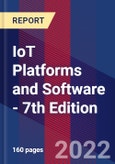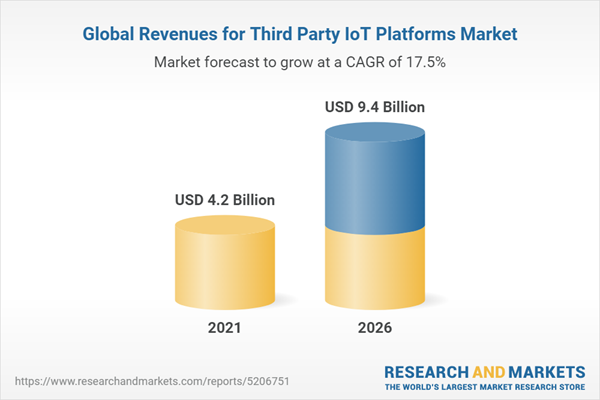The IoT Platform Market Reached US$ 4.2 billion in 2021
Increasingly complex IoT solutions require more advanced communication platforms and middleware that facilitate seamless integration of devices, networks and applications. This new 160-page study analyses the latest developments on the IoT connectivity management, device management and application enablement platform markets. The analyst estimates that total revenues for third party IoT platforms will grow at a compound annual growth rate (CAGR) of 17.5 percent from US$ 4.2 billion in 2021 to US$ 9.4 billion in 2026. Get up to date with the latest trends and information about vendors, products and markets.
Highlights from the Report:
- 360-degree overview of the IoT ecosystem.
- Insights from 30 executive interviews with market leading companies.
- Summary of the latest industry trends and developments.
- Updated in-depth profiles of key players in the IoT platform market.
- Reviews of the market strategies of leading platform vendors.
- Perspectives on the evolution from vertical M2M solutions to the broader scale and scope of the IoT.
- Extensive global market forecasts lasting until 2026.
The 500 largest cellular IoT deployments together account for 480 million units
Berg Insight presents a unique database covering the 500 largest cellular IoT deployments identified as part of the company’s world-class IoT market research activities since 2004. The extensive list includes various types of projects and product categories deployed across all types of vertical markets including OEM automotive, aftermarket automotive, transport & logistics, utilities, infrastructure, buildings & security, retail, industrial, consumer electronics, healthcare and others. The database includes project size and geographical distribution by the end of 2021 as well as a 5-year forecast for each individual project.
“The projects included in the top-500 list together account for approximately 480 million active cellular IoT subscriptions”, said Rickard Andersson, Principal Analyst. He adds that this corresponds to as much as 22.8 percent of the total number of cellular IoT connections worldwide at the end of 2021. The 500 projects on the list are in the coming years forecasted to grow to 949 million units by 2026, corresponding to an overall compound annual growth rate (CAGR) of 14.6 percent. “More than 90 deployments on the list have surpassed 1 million subscriptions and the top-10 projects alone account for over 159 million units”, continued Mr. Andersson. Transport & Logistics is the largest vertical in terms of the number of projects that made the top list, followed by aftermarket automotive, retail, utilities, OEM automotive, buildings & security, healthcare and industrial. “When comparing the number of active subscriptions represented by each vertical for the entries in the top-500 list, OEM automotive is instead the largest vertical, accounting for 157 million units, ahead of utilities at 89 million units and transport & logistics representing 96 million units”, concluded Mr. Andersson.
The Report Answers the Following Questions:
- Which trends and developments are shaping the IoT platform market?
- What are the benefits of using commercial IoT platforms?
- Who are the leading providers of IoT platforms?
- What are the main drivers behind the adoption of IoT platforms?
- Which are the leading IoT platform vendors in the major market verticals?
- What are the key features of the application enablement platforms available today?
- Which mobile operators have deployed IoT CMPs from third party vendors?
- What is the potential market size for commercial IoT platforms?
Who should read this report?
IoT Platforms and Software is the foremost source of information about third party IoT platforms and related software for IoT solutions. Whether you are a device vendor, system integrator, service provider, telecom operator, investor, consultant, or government agency, you will gain valuable insights from this in-depth research.
Table of Contents
Executive Summary
Executive Summary
IoT platforms provide developers with tools to connect and manage devices and integrate collected data into various applications and services. These platforms are intended to reduce the cost and development time for IoT solutions by providing standardised components that enterprises can build upon. Broadly speaking, most IoT platforms fall into one of the following three categories: connectivity management platforms, device management platforms and application enablement platforms.
Connectivity management platforms (CMPs) allow mobile operators to support their enterprise customers by providing functionality for provisioning, subscription management, cost monitoring and event management. About 67 percent of the global installed base of 1.74 billion IoT SIMs were managed using commercial connectivity management platforms (CMPs) at the end of 2020. Huawei is the leading IoT CMP vendor in terms of volume with close ties to the domestic operator's China Mobile and China Telecom and managed over 900 million IoT SIMs in Q2-2021. Whale Cloud, formerly known as ZTEsoft and partly owned by Alibaba Group since 2018, is the runner up on the Chinese market. Cisco is the dominant IoT CMP vendor outside of China with about 180 million connections in mid-2021, followed by Vodafone and Ericsson.
Several players have entered the IoT CMP market in recent years. Mavoco delivers the IoT CMP of Nokia’s WING offering, a managed service leveraging a global core network. Similarly, EMnify’s and floLIVE’s product concepts encompass IoT CMPs and distributed core networks deployed in key countries and regions. 1NCE provides an IoT CMP offering since mid-2019 for third-party service providers that want to address high-volume, low bandwidth use cases. Addressing enterprise pain points related to multi-platform SIM deployments, IoTM provides a bring-your-own MNO platform, enabling the management of large-scale SIM deployments through integrations with third-party CMPs. IoT CMPs are also a key component in the value proposition from IoT managed service providers such as Aeris, KORE, Wireless Logic, Cubic Telecom and Sierra Wireless.
The market for IoT device management and application enablement platforms is in a stage of transformation, driven by investments from the major cloud service providers Microsoft, AWS, Google and Alibaba. While IoT platform vendors have always had strengths and weaknesses, recent developments have led many vendors to re-align their solutions with a renewed focus on core capabilities. In many cases, vendors that have built IoT platforms on public cloud infrastructure are transitioning to provide higher-level building blocks that can be used as a starting point when building solutions and even end-to-end solutions for specific use cases. The trend has accelerated in 2020–2021 as a number of major industrial software vendors exited the IoT platforms market.
IoT platform providers span from start-ups to major technology companies, device makers and industrial software vendors. In the industrial sector, PTC continues to expand, leveraging its strategic alliances with Rockwell Automation and Microsoft. Both Microsoft and AWS have recently put efforts into providing more capabilities for edge devices while extending their reach into the industrial markets. Asset-heavy companies like Hitachi leverage their expertise in both the operational technology and information technology domains to help customers increase asset performance and process efficiency. Important IoT platform providers with high involvement in the industrial sector further include the vendors Altair Engineering, Davra, Device Insight, Eurotech, Exosite, Losant, Relayr, Software AG and Waylay.
A varying degree of system integration is however still required to build and deploy an IoT solution. While large customers typically have the capabilities to integrate devices into their system architecture in-house, small and medium-sized firms turn to system integrators when investing in IoT solutions. To address this gap in the market, a group of vendors have developed full-stack IoT platforms, spanning hardware, embedded operating systems, platform services and applications. These solutions are designed to provide an integrated set of customisable building blocks to shorten the journey from prototyping to deployment. Tuya has emerged as the most prominent full-stack IoT platform vendor with a strong presence in the consumer electronics market. Other vendors with similar product concepts are Twilio that acquired Electric Imp in mid-2020, as well as Particle, Ayla Networks, Pycom and Taoglas. The publisher's estimates that the market for commercial device management and application enablement platforms amounted to US$ 2.6 billion in 2020. Growing at a CAGR of 28 percent, the market value is expected to reach US$ 9.0 billion in 2025.
Companies Mentioned (Partial List)
A selection of companies mentioned in this report includes, but is not limited to:
- 1NCE
- Actility
- Aeris
- Airnity
- Alibaba Group
- Altair Engineering
- Amazon
- Amplía
- AVSystem
- Ayla Networks
- BICS
- Blues Wireless
- C3.ai
- Caburn Group
- China Mobile
- Cisco
- Comarch
- Cubic Telecom
- Davra
- Deutsche Telekom
- Device Insight
- Embever
- EMnify
- Enea
- Ericsson
- Eseye
- Eurotech
- Exosite
- Flickswitch
- floLIVE
- Friendly Technologies
- Giesecke+Devrient
- Hitachi
- Hologram
- Huawei
- iBASIS
- IDEMIA
- IoT managed service providers
- IoTerop
- IoTM Solutions
- Izuma Networks
- Kigen
- KORE Wireless
- Losant
- MAVOCO
- Microsoft
- Nexign
- Nokia
- NTELS
- Onomondo
- Orange
- Particle
- Pelion
- Pod Group (Giesecke+Devrient)
- PTC
- Relayr
- Sierra Wireless
- SIM solution providers
- Software AG
- Soracom
- Taoglas
- Tata Communications
- Telefónica
- Telit
- Thales
- Transatel
- Truphone
- Tuya
- Twilio
- u-blox
- Velos IoT
- Verizon
- Vodafone
- Waylay
- Whale Cloud
- Wireless Logic
Table Information
| Report Attribute | Details |
|---|---|
| No. of Pages | 160 |
| Published | December 2022 |
| Forecast Period | 2021 - 2026 |
| Estimated Market Value ( USD | $ 4.2 Billion |
| Forecasted Market Value ( USD | $ 9.4 Billion |
| Compound Annual Growth Rate | 17.5% |
| Regions Covered | Global |









